In Kyiv, Soviet-era monuments to Russian-Ukraine unity still stand. But should they?
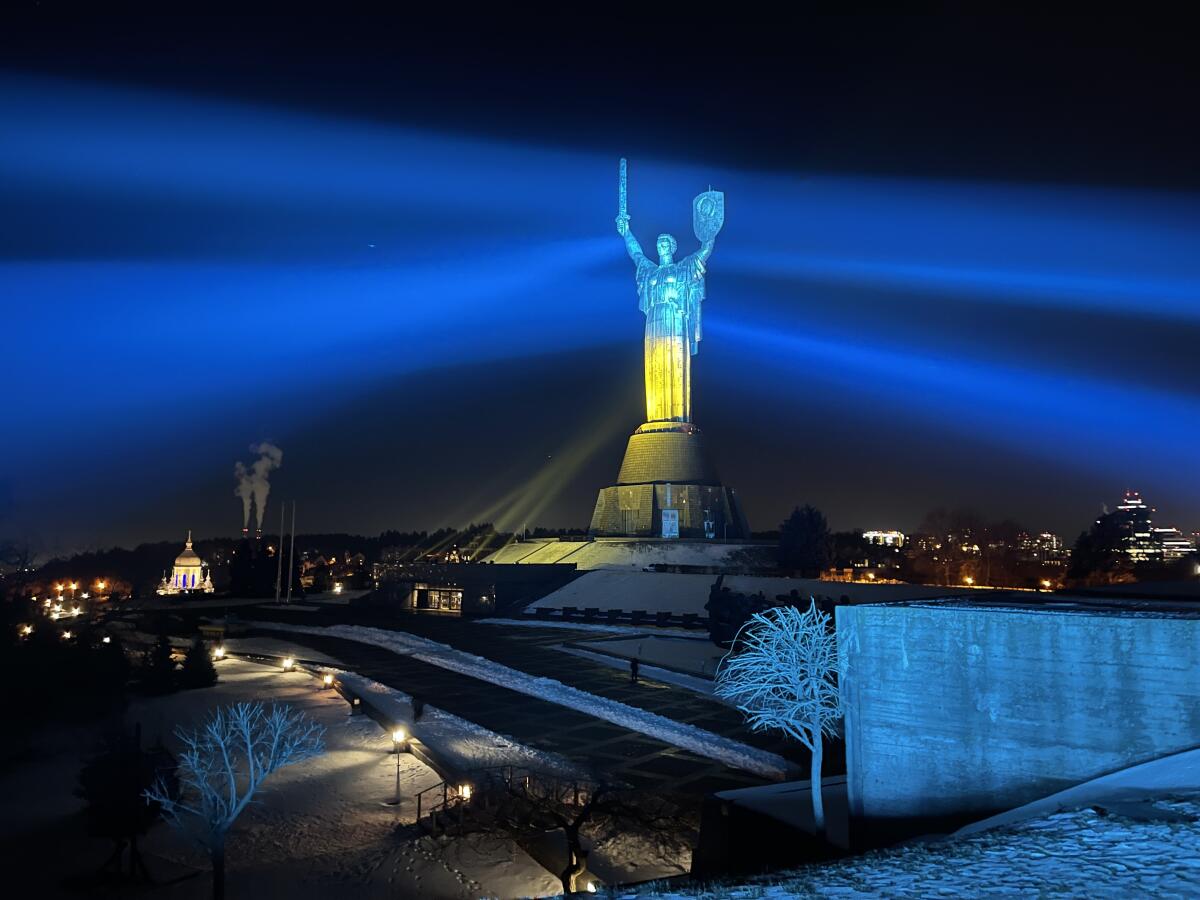
- Share via
My journey writing this week’s Essential Arts newsletter somehow went from philosophical debates over Ukrainian monuments to 1980s singer-songwriter Debbie Gibson’s hit “Foolish Beat,” Rick Astley’s “Together Forever” and Def Leppard’s “Pour Some Sugar on Me.” Please send help. I’m entertainment editor Craig Nakano filling in for Carolina Miranda, whom I’m happy to report will be back in the Essential Arts driver’s seat soon. But until then …
Ukraine’s monument debate
Headlines last week marking the first anniversary of Russia’s invasion of Ukraine prompted me to unearth a very old photo album — spine broken, magnetic pages yellowed, the 4x6 prints’ cellophane covers rumpled at the edges. On the opening page, the orderly handwriting of my 16-year-old self announced the date: “June 25, 1988.”
I leafed through the Kodak prints that followed, reliving a 10-day “cultural exchange” of what was the Soviet Union at the time — when Gibson was topping Billboard’s singles chart, Astley was at No. 3 and “Pour Some Sugar” rounded out the Top 10. (Ooof, the ’80s.) Sandwiched between pictures of Red Square in Moscow and the State Hermitage Museum in St. Petersburg (called Leningrad back then) were slightly out-of-focus shots of three massive monuments in Kyiv (formerly known as Kiev).
One faded image captured the Motherland Monument, a female warrior sheathed in gleaming steel, her sword rising about 335 feet into the sky — higher than the torch of the Statue of Liberty. Built in 1981, regarded by critics as a piece of Russian propaganda and derided as an attempt to oppress Ukrainian culture, the Motherland figure in my picture held a shield emblazoned with a Soviet hammer and sickle.
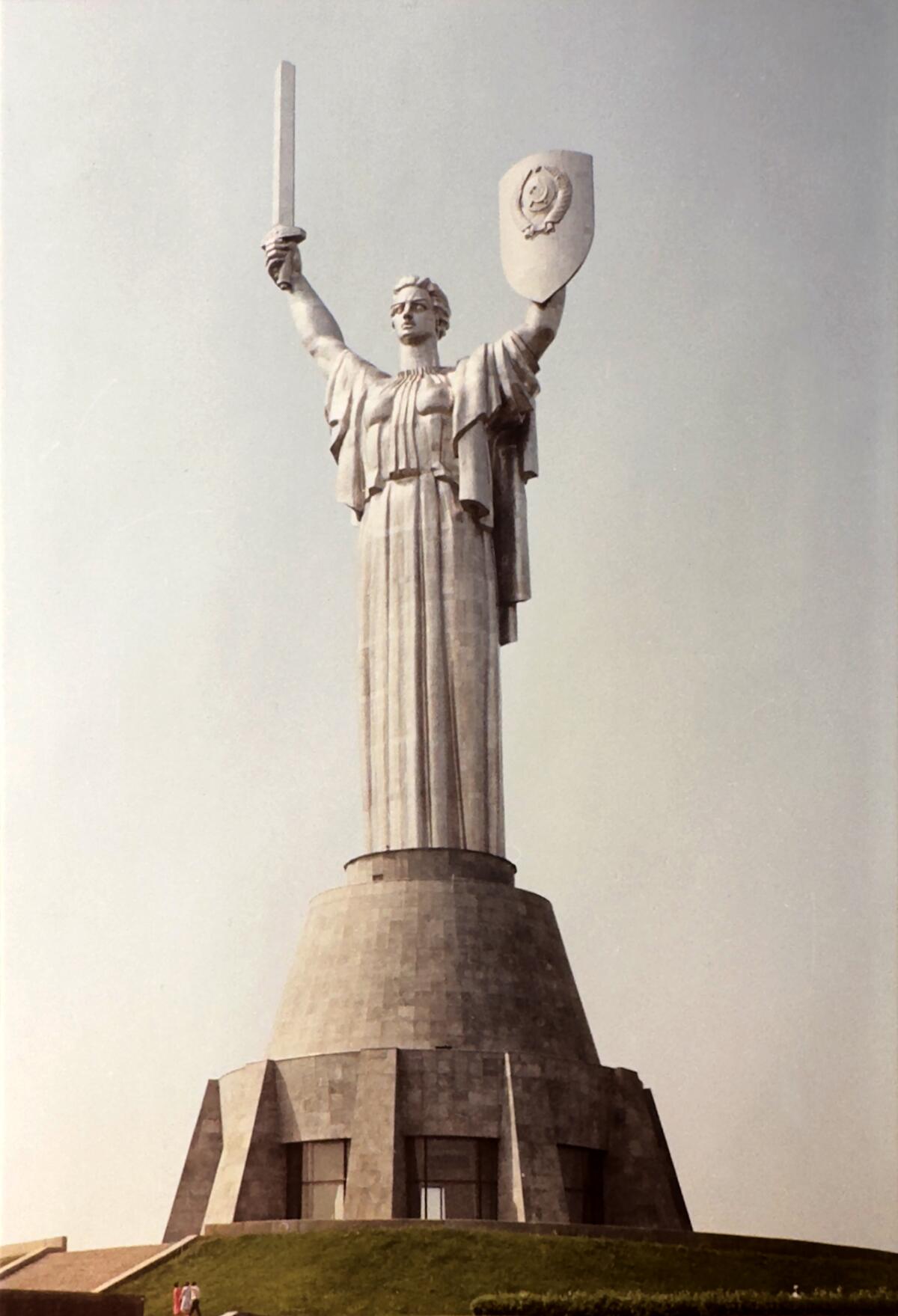
Make the most of L.A.
Get our guide to events and happenings in the SoCal arts scene. In your inbox every Monday and Friday morning.
You may occasionally receive promotional content from the Los Angeles Times.
In another picture, the massive titanium People’s Friendship Arch reached into the clouds over Kyiv parkland like some Ukrainian version of the Gateway Arch in St. Louis. Beneath it, two 27-foot-tall bronze statues depicting Ukrainian and Russian workers hoisted above their heads (and killer abs) what looked like a massive medallion. It was, as Google later told me, the Soviet Order of Friendship, representing the unity of Russian and Ukrainian peoples.
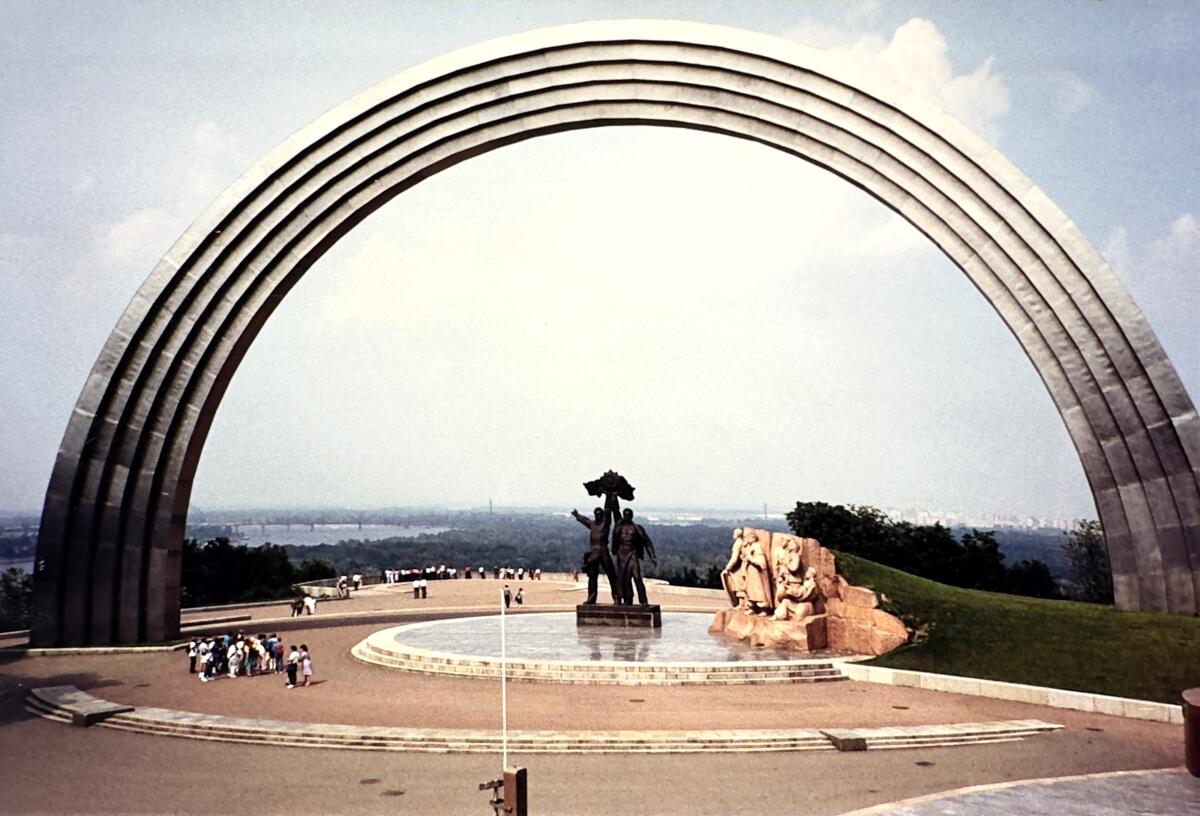
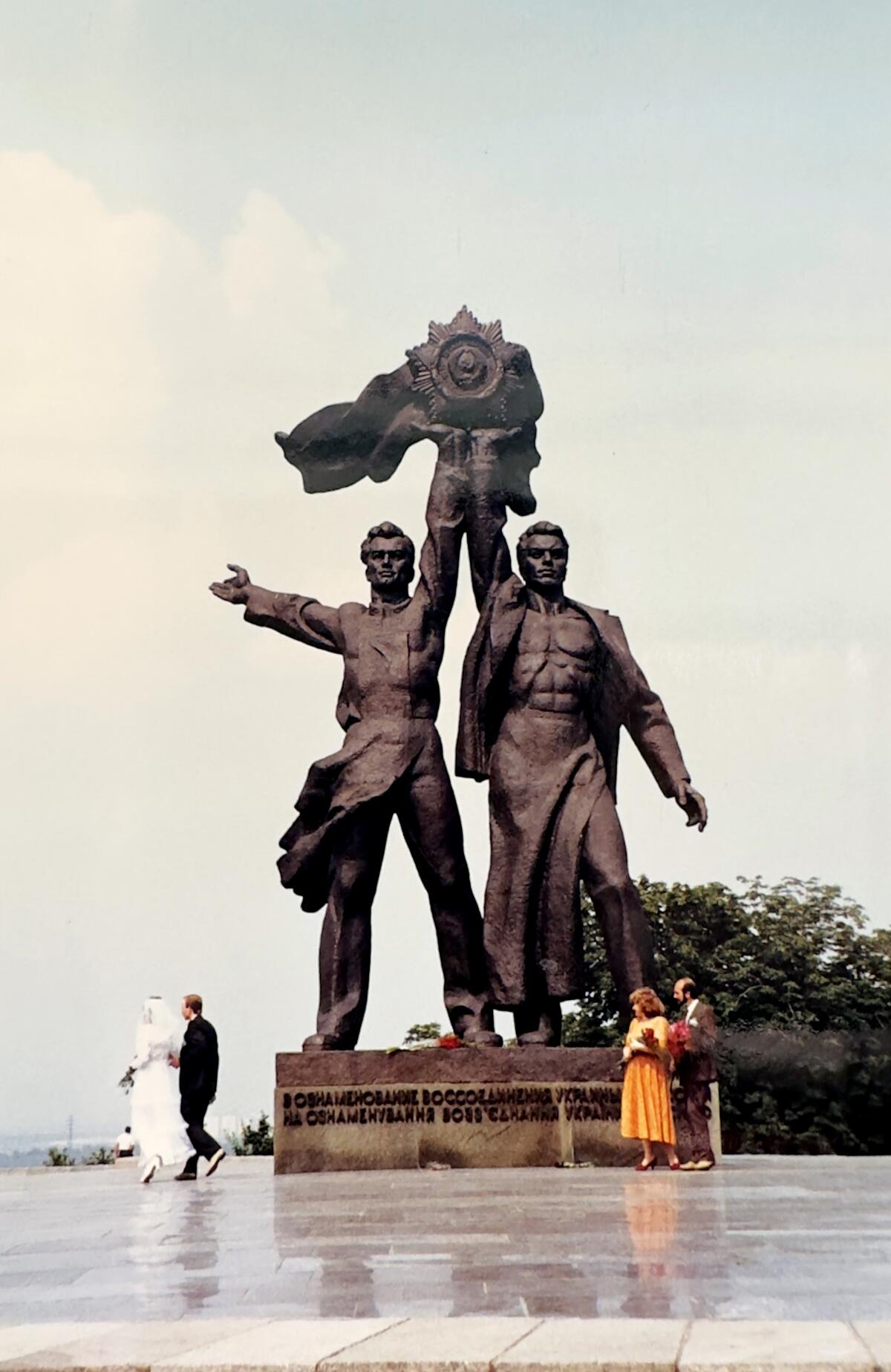
At the time of my visit, the monuments were presented as celebrations of Russian-Ukrainian unification, politically and culturally. Thirty-five years later, post-invasion, I wondered about the fate of structures that ultimately became symbols of Moscow’s control in the Union of Soviet Socialist Republics. Were the monuments still standing? If Russians hadn’t already leveled them in the bombing of Kyiv, would the Ukrainians want to finish them off themselves?
The trip to Motherland
Kyiv was more than 6,000 miles from Lafayette, the Bay Area town where I grew up. My mom dreamed of traveling the world, but with money tight, the closest we got was watching PBS specials about the Egyptian pyramids and the mystery of Machu Picchu. Summer vacation was always at a family friend’s cabin at Lake Tahoe. By junior year of high school, the farthest I had traveled was Tijuana.
Any cash I earned from mowing neighbors’ lawns at $6 a pop (front and back yard) went into the bank for college. I had saved about $1,500 when friends asked if I wanted to join their tour group to the Soviet Union. Cost: $1,500.
Spending my college fund on a vacation was preposterous to suggest. Dad had already forbidden me from applying to out-of-state colleges because of the higher expense. When I announced I was applying to Northwestern, my mother’s response was simply, “We’re not private-school people.”
I begged Mom, who of course dreamed for me all the things she didn’t have herself. And that is how I found myself on my first plane ever: TWA Flight 842 from SFO to JFK, connecting to Brussels and then West Berlin, with a bus transfer to East Berlin and an Interflug flight to Moscow. After two days in the capital, we were off on an 11-hour train ride to Kyiv.
The Motherland Monument was a spectacular sight, its sheer size a triumph against gravity: 280-ton steel core, 108 tons of auxiliary plating, 90 tons of 1.5mm-thick stainless steel sheathing. Welding seams stretched for nearly 19 miles. She looked invincible. But could she be impervious to modern long-range missiles?
This week I reached out to the Museum of the History of Ukraine in the Second World War, which encompasses the site along the Dnipro River where the Motherland Monument stands.
Yes, Motherland is safe, said Yurii Savchuk, director general of the museum. In fact, a funny thing has happened since Russia invaded: The monument has evolved into a Ukrainian symbol of the struggle and resistance.
“In the very first days of the defense of the capital, the citizens of Kyiv remembered that the monument, though Soviet, looks towards Moscow and shields Kyiv from threats,” Savchuk said by email. Digital artists — Oleksandr Grekhov, Nikita Titov, Nato Mikeladze, Anta Frirean and others — created dozens of images incorporating Motherland, he said. Museum staff were inspired to create a thematic collection that was exhibited as part of “Motherland. Reinterpretation.”
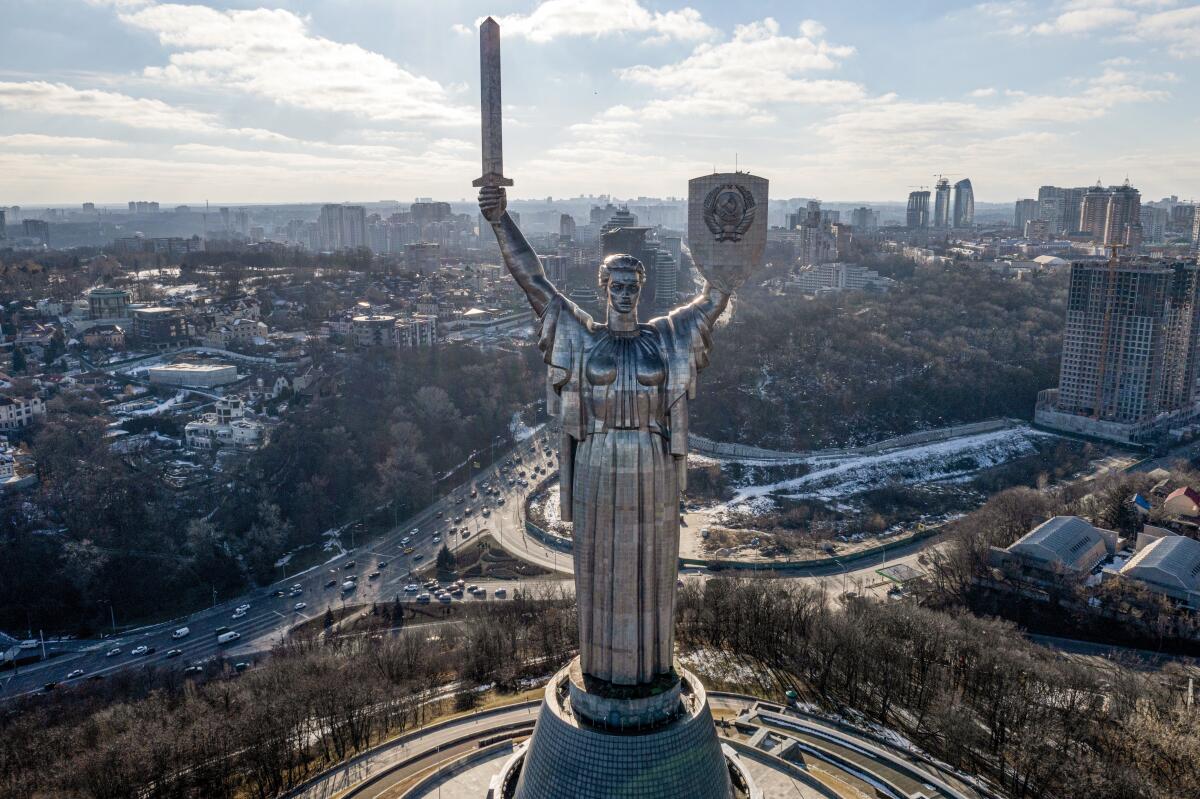
Prior to the war, Ukraine, like other former Soviet republics, had embarked on a “derussification” and “decommunization” campaign to remove remnants of Soviet propaganda, such as the hammer and sickle on Motherland’s shield. Last July, Savchuk said, at the initiative of the Ukrainian Institute of National Memory, nearly 800,000 Ukrainians voted on the fate of the shield. Ninety-four percent wanted the Soviet coat of arms removed and replaced with the Ukrainian trident, and the museum is seeking the technical resources and money to make that happen, he said.
What about that titanium arch with the bronze Russian and Ukrainian workers below, looking like one big happy Soviet family? That one is a little more complicated.
Just as the fate of certain monuments has sparked so much debate in the U.S., so too do Soviet monuments in Ukraine. Some older Ukrainians and ethnic Russians living in Ukraine don’t see the works as Soviet monuments but rather as World War II monuments — crucial ways of preserving the memory of heroes who died fighting Nazi Germany. They see the destruction of monuments as an erasure of history. Even many critics want the monuments to remain standing — just with added signage or interpretation that can provide context and acknowledge the ways in which the monuments are problematic. (Ukrainian website the Village published an enlightening range of opinions on the subject.)
One Ukrainian who’s been vocal about preserving the arch was Volodymyr Kuznetsov, for whom the solution wasn’t to tear down but rather to tweak. To call attention to the Kremlin’s political persecution and detention of Ukrainian citizens, Kuznetsov led a project that painted a giant black crack on the arch. The symbol of Russian-Ukrainian unity appeared to be breaking into two.
In an email interview, Kuznetsov drew a distinction between the arch and statues aggrandizing Lenin and other “Russian empire persons.” Sure, knock the latter down, he said. (In our conversation, I recalled how my ’88 tour guide said that when a Russian and a Ukrainian got married, they would lay flowers at the foot of the bronze as a symbol of two peoples becoming one. Kuznetsov corrected that narrative: Couples leave flowers at monuments for various reasons, and he linked to news coverage about the revived tradition in Russia of newlyweds laying flowers at statues of Lenin.)
“What I’ll say to fellow Ukrainians who see Soviet-era monuments as symbols of oppression and who want those monuments taken down: There are different monuments, some of them have art value. These ones I agree to keep.”
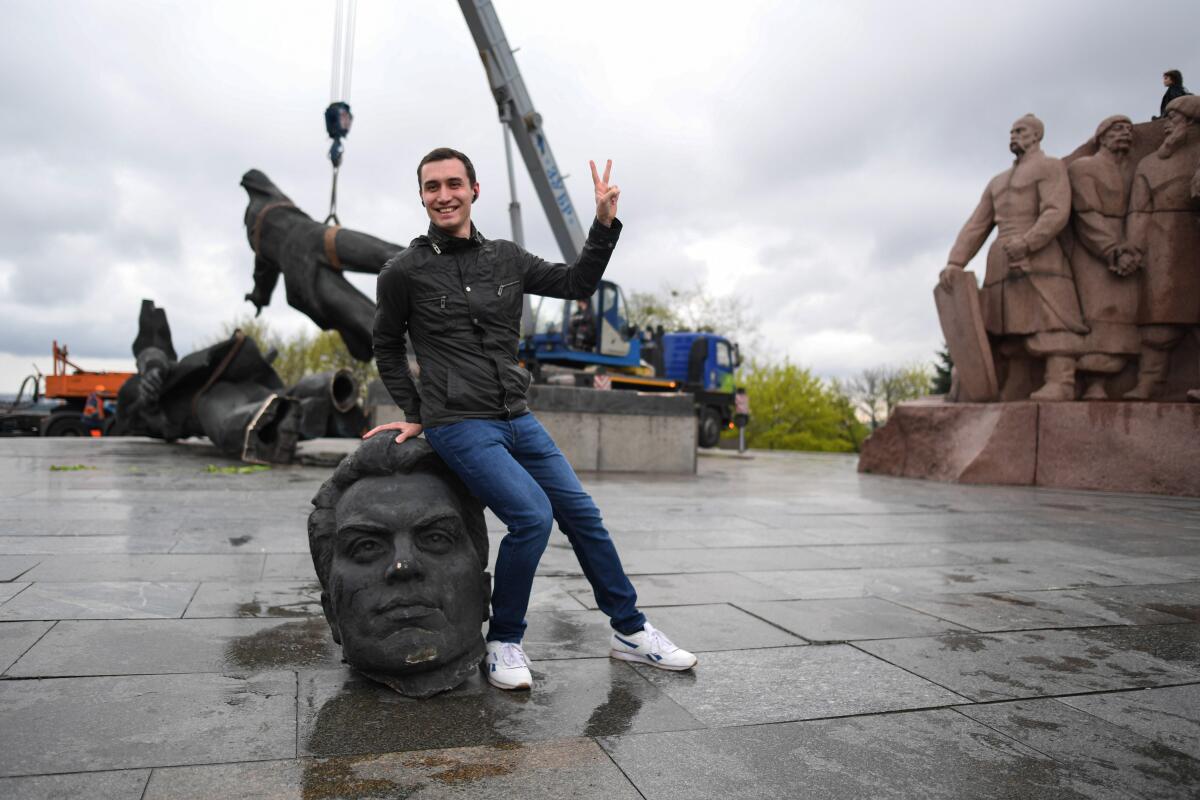
The arch does remain, and last year it was renamed the Arch of Freedom of the Ukrainian People. The bronze of united Russian and Ukrainian workers is no more, however. It was dismantled in April with fanfare from Kyiv Mayor Vitali Klitschko. A Reuters news story noted that as workers started dismantling one of the bronze heads, it “fell to the ground with a hollow clang.”
Over at the Motherland Monument every Aug. 24 — Independence Day in Ukraine — officials typically spotlight the steel in the colors of the national flag, the city’s warrior and protector pointed toward Moscow in beams of yellow and blue. In wartime, Savchuk said, it’s hard to predict whether the city will be able to repeat the tradition this year.
In the meantime, the museum’s website offers a message in bold red type: “The Russian-Ukrainian war continues. See you after the victory!”

Closer to home
Where to start in another week of Peak Arts? Let’s start with the biggie, the Ahmanson Theatre downtown, where Times critic Charles McNulty has some words about creative choices in “The Secret Garden,” including a part of the set design “that looks like an internal organ but is a simulacrum for the sun and moon.”
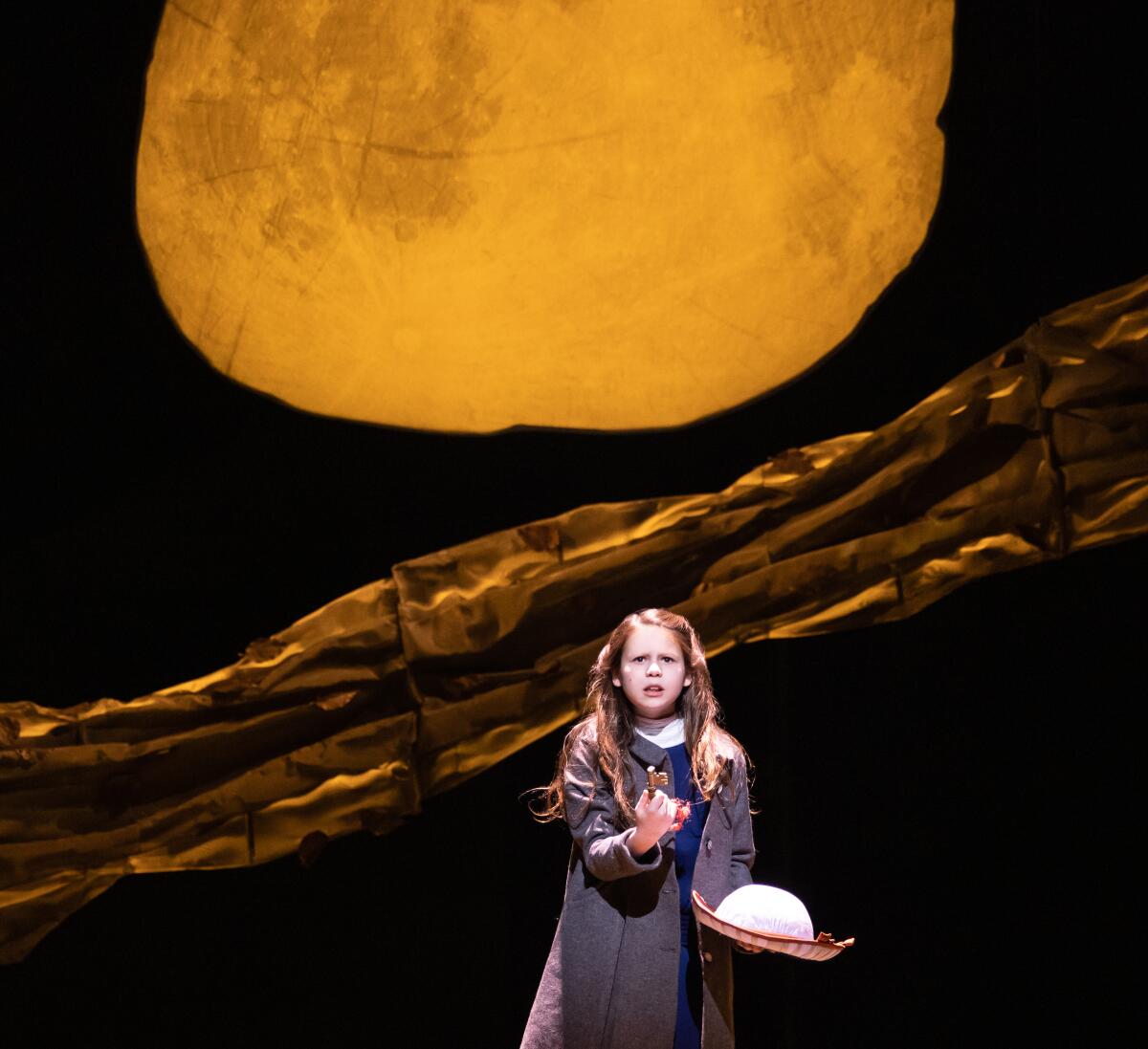
McNulty found more to contemplate in “The Lifespan of a Fact,” a 2018 play about truth in journalism by Jeremy Kareken, David Murrell and Gordon Farrell at the Fountain Theatre in East Hollywood, concluding: “Sweating the small details at a time when authoritarians are blurring the line between fact and fiction is urgent business.”
Contributor Lisa Fung has the early look at the revival of “Twilight: Los Angeles, 1992,” which begins previews Wednesday at the Mark Taper Forum. In what became a cornerstone of the L.A. theater canon three decades ago, Anna Deavere Smith embodied some 40 real-life people reflecting on Rodney King and the L.A. riots that followed his beating. This time around, five actors — Hugo Armstrong, Lisa Reneé Pitts, Jeanne Sakata, Sabina Zúñiga Varela and Lovensky Jean-Baptiste — will take the stage under the direction of Gregg T. Daniel.

In theater news from another world — the Upside Down, to be specific — Netflix released details about “Stranger Things: The First Shadow,” a new play that will serve as a prequel to the streaming series. Times staff writer Nardine Saad has the deets: Kate Trefry, a writer and co-executive producer on the TV show, wrote the play based on a original story she co-conceived with Matt and Ross Duffer and Jack Thorne. Stephen Daldry will direct “with co-direction from Justin Martin.” The target opening is late 2023 at the Phoenix Theatre in London’s West End.
Enjoying this newsletter? Consider subscribing to the Los Angeles Times
Your support helps us deliver the news that matters most. Become a subscriber.
Forest music
“Treelogy,” one of the year’s buzziest classical projects, has been touring California State University campuses this week — Chico on Tuesday and Sonoma on Thursday. Our critic Mark Swed caught the premiere at the Soraya in Northridge, which commissioned Billy Childs, Gabriella Smith and Steven Mackey to compose musical meditations on the sequoia, the Joshua tree and the redwood, respectively. “Whether or not one hears trees in this ... is hardly the point,” Swed writes. On a subliminal level, three splendid pieces of music join a chorus of concern for our changing climate and the California landscape we know and love.
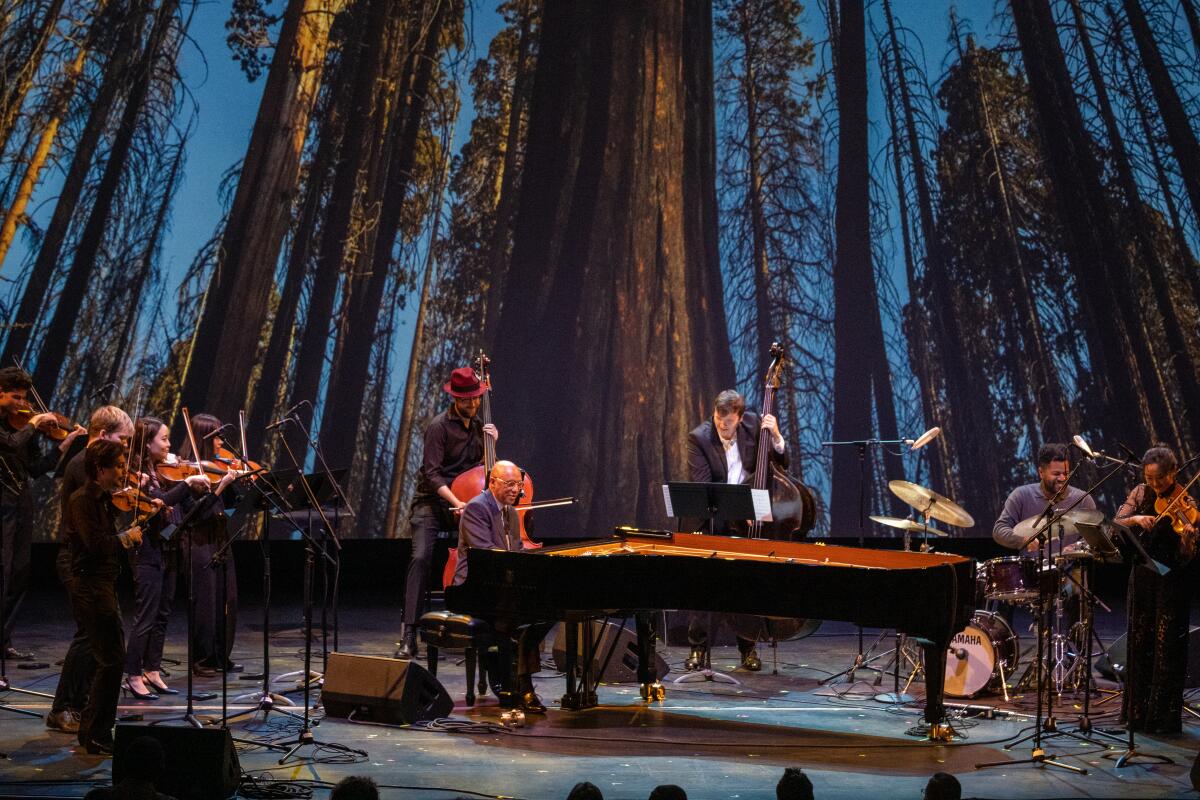
Times staff writer (and L.A. Goes Out newsletter host) Steven Vargas gives the back story to another hot ticket in town: The L.A. Dance Project premiere of a piece by Jamar Roberts, former resident choreographer of Alvin Ailey American Dance Theater. His new work, “Lineage,” Vargas writes, was informed by dreams about his grandmother.
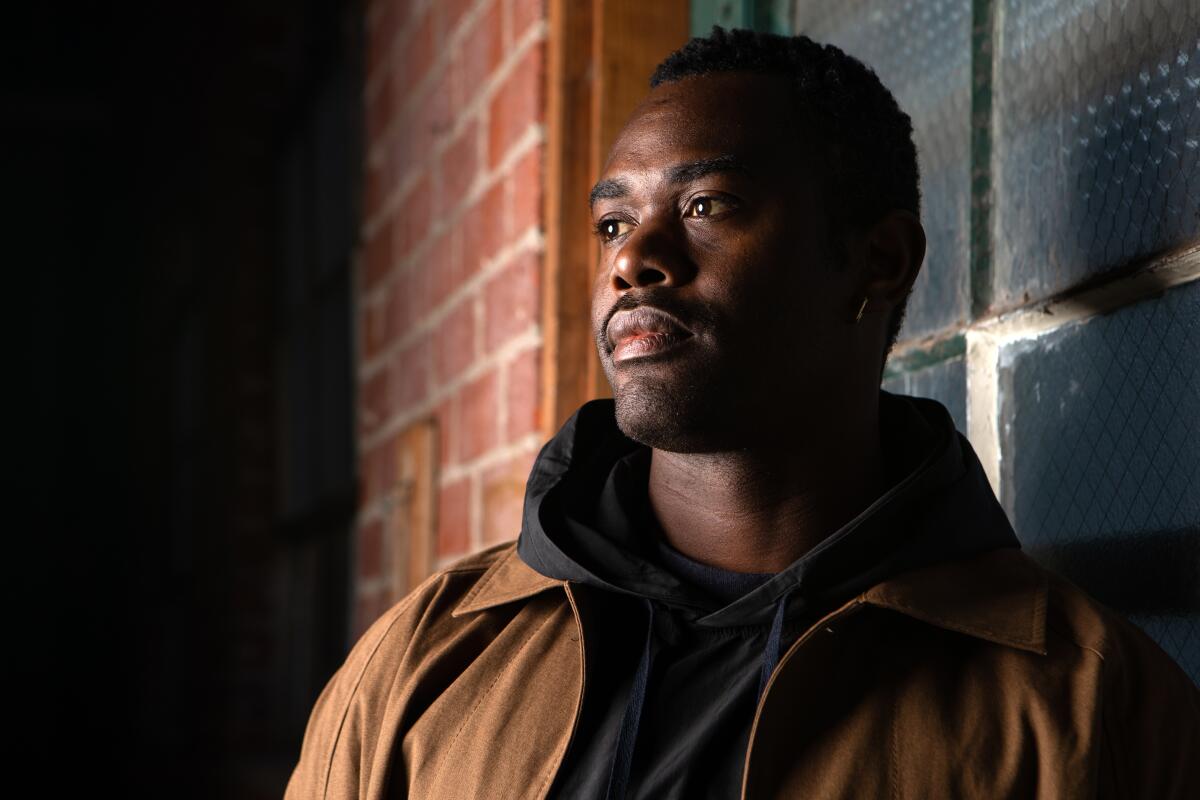
At the top of the week, meanwhile, Jessica Gelt reported highlights of the Los Angeles Philharmonic‘s 2023-24 season, which will celebrate the 20th anniversary of Walt Disney Concert Hall. Released on architect Frank Gehry’s 94th birthday, the lineup includes concerts that take on new urgency as the countdown begins for Music and Artistic Director Gustavo Dudamel’s 2026 departure for the New York Philharmonic.
‘Pretty and grotesque’
Frieze is over (exhausted reporters, rejoice!), but staff writer Deborah Vankin was back on the beat, this time talking with painter Robert Russell about the subjects of his latest work at Anat Ebgi gallery in L.A.’s Carthay neighborhood: tiny animal figurines produced in Germany in the 1930s and ’40s by the Allach Porcelain Manufacturing Co. Russell, who is Jewish, was interested in the tchotchkes’ darker history: “Nazi Party leader Heinrich Himmler, through the SS, took over the company in the mid-1930s and used it to produce, among other things, porcelain statuettes that conveyed his love of Aryanism,” Vankin writes. Russell chose to paint the kind of gifts that SS soldiers received as congratulations for promotions, marriage, a new baby. You can hear more from the artist here.
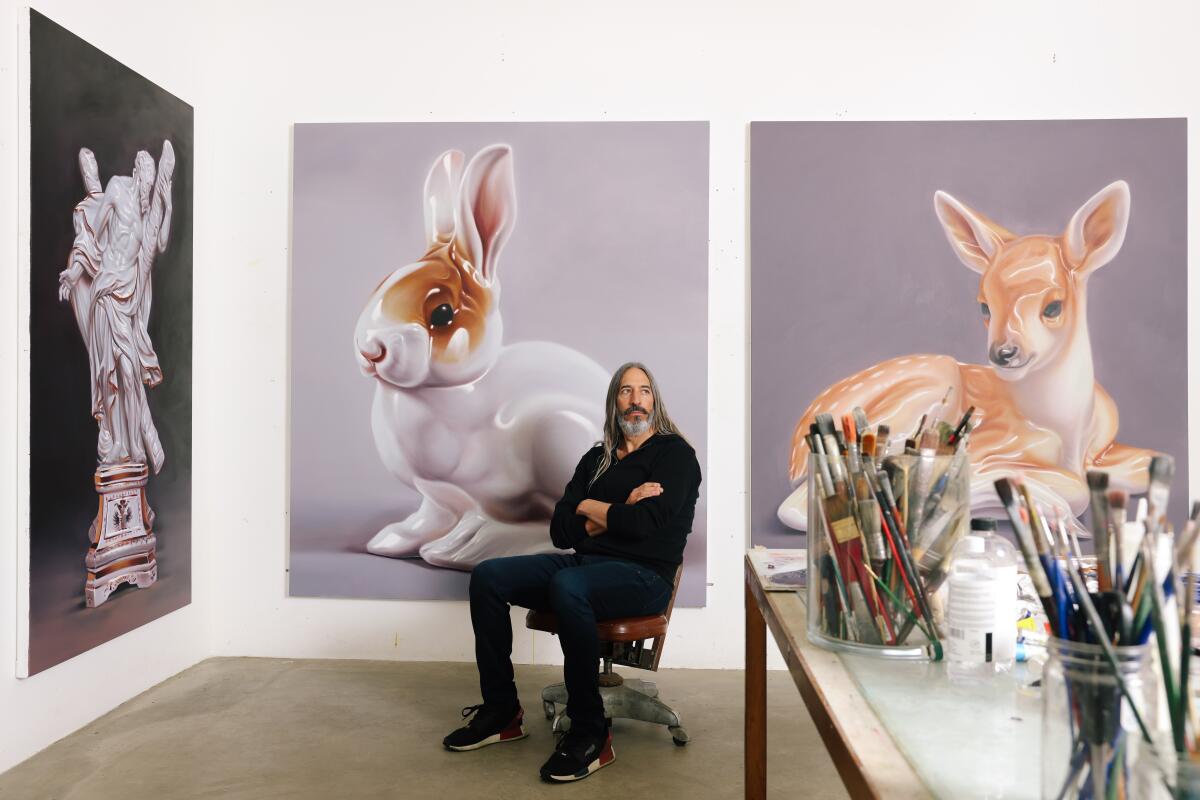
Meanwhile, Vargas was scouting the USC Fisher Museum of Art, which has the first L.A. solo show for Mulyana, an Indonesian artist known for knitting and crocheting marine life out of worn clothing, plastic bags and other detritus. A significant portion of Mulyana’s “Ocean Wonderland” is interactive, Vargas writes, inviting viewers to create their own monsters with a mirror and loose body parts.
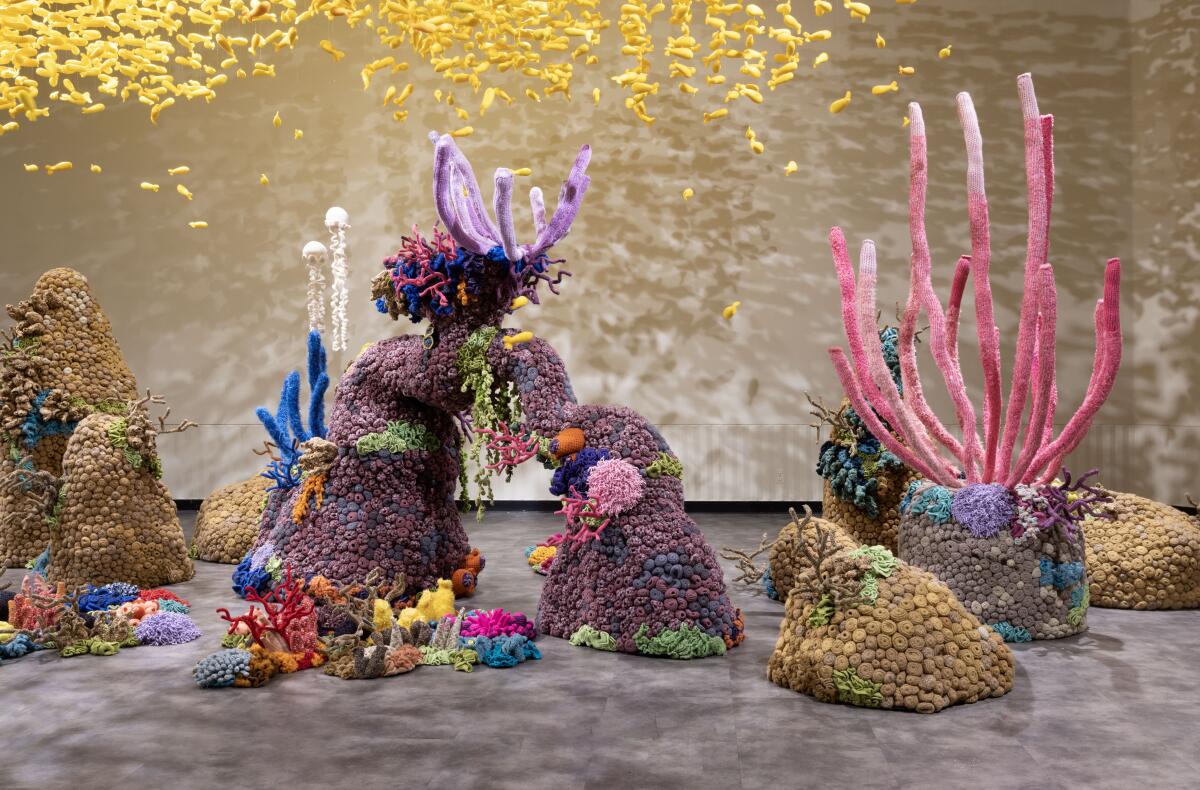
Times contributor Eva Recinos brings us a profile of artist Pamela Smith Hudson, who grew up the daughter of a mason in Compton, where mortar, plaster and grout were the materials of life. Today much of Hudson’s work is mixed media, using wax, clay and other materials to create the texture of sand or the appearance of crates. Her new show at Craig Krull Gallery, Recinos writes, is transporting.
That rather hideous Marilyn sculpture
Art critic Christopher Knight flagged for me Friday that a three-judge panel of California’s 4th District Court of Appeals has overturned a lower court’s dismissal of a lawsuit over the 26-foot-tall Marilyn Monroe statue in front of the Palm Springs Art Museum. You know, the one that all but encourages tourists to get between her legs and take pictures up her dress?
The appeals court ruled that the city exceeded its authority in closing Museum Way and placing the statue in the center of the thoroughfare as a tourist attraction. The court also dismissed the city’s claim that a minimum three-year display of the controversial statue, which shows Monroe’s dress blowing up around her waist to expose her backside and crotch, qualifies as a “temporary” street closure. The city also was faulted for exempting the project from mandated environmental review and was directed to cover appeal costs for the plaintiffs, a group of local citizens assembled as the Committee to Relocate Marilyn.
And last but not least ...
Angelenos were giddy that someone has discovered a worse job than Hollywood assistant: It’s Art World Family assistant. If you’ve had the week I’ve had and need a smile, may I recommend Jessica Gelt’s parody of the job posting that had art Twitter in a tizzy.
The biggest entertainment stories
Get our big stories about Hollywood, film, television, music, arts, culture and more right in your inbox as soon as they publish.
You may occasionally receive promotional content from the Los Angeles Times.




